Serendipity
By Ken Myers kmyersefo@aol.com
Somehow I never know where I'll end up when I try to do a simple thing regarding this hobby.
I recently received an email from Bob Aberle. He had attached the campaign statement of Dave Mathewson, who is running for AMA president. Bob noted that Dave is an active e-flier and felt that he had some important things to say in his statement in his bid for president of the AMA. SEFLI (www.sefli.org) printed Dave's statement in their August newsletter (www.sefli.org/news_04.htm).
To be fair, I went to the AMA site (www.modelaircraft.org) looking for the statements of the other candidates, Dave Brown and Bill Oberdieck. I couldn't find them, so I decided that the statements must be on the members' only section of the site. Again, for about the fifth time, I tried to get to the members' only section. No luck.
I spotted a "new" page on the AMA site that explained why I might be having a problem and what to do about it. (www.modelaircraft.org/templates/ama/passwordsos.asp)
I tried having the info sent to my AOL address. Again, I met with failure. Next I sent an email to the address on the Web page.
I received an AOL email sent from shawng@modelaircraft.org. He provided the link necessary to get my password, and it worked! Thank you Shawn!
He also noted the following; "There are various internet service providers that are trashing the emails we send to emails that are hosted on their system (AOL and Earthlink are just two of those internet providers). These emails are getting deleted before they ever reach your email. We apologize for this fact and we are currently looking at ways to correct this situation."
If you are an AMA member having a problem getting a password, please check out the page noted above.
I now had my password and entered the members' only area, but I still could not find the campaign statements. This was towards the end of August. You should have received your ballots and statements by now.
Please read the candidates' statements, decide who you'd like to lead us, and do vote!
Since I was at the AMA site, I decided to take a look and see what was new on the Model Aviation's Sport Aviator site (www.masportaviator.com). The site is a Webzine devoted to the beginner and is free to everyone. I saw that Bob Aberle had an article on using Li-Po (Li-Poly) cells in Hobby Lobby's Bonnier 20 ARF (www.masportaviator.com/ah.asp?CatID=2&ID=43). Reading this article lead to the original Bonnie 20 review (www.masportaviator.com/ah.asp?CatID=1&ID=39).
The review and article are excellent, and the two end boxes of the review give all of the pertinent data.
As usual, all this data got me to "thinking", so I took a look at the recommended power system as used. I played with the numbers for a while and found that the AXI 2820/10 (outrunner-type brushless) appears to be about 75% efficient when used with eight cells and the 23 amp draw that the APC 10x7E prop provided at 6,900 RPM.
With the low power output, about 130 watts, I was curious as to how this tricycle-geared plane flew off of a normal grass flying field, so I sent an email to Bob inquiring about it.
Next, I reread the Li-Po article and found my answer there when Bob said, "The two NiMH and the one Ni-CD battery packs proved they could fly the BONNIE in an acceptable fashion for periods ranging from 5 to 8 minutes." He also stated, "While it flys well on the traditional Ni-CD and NiMH battery packs, it becomes a spectacular performer when you 'move up' to a three-cell Li-Poly battery pack."
By the time I had done all this "thinking", Bob had sent another email. He said that the Bonnie 20 "is actually much better than the --- 'numbers'."
So, what does all this prove? While running the numbers can help in deciding how best to power an electric R/C plane, the best way to do it is to find someone who has set up the same plane, or a similar plane, and had great results. If you are looking for an advanced trainer, read Bob's articles. And finally, don't be surprised where this hobby can lead you! Enjoy the serendipity of life. It's quite a ride.
Return to "What's In This Issue?"
Horton-like Reborn in Portugal
From Paulo "Chispas" Faustino chispas@sapo.pt
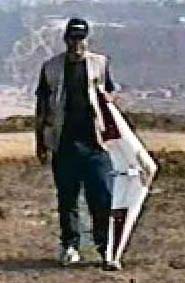
After a crash six years ago she returned to the same slope with a brushless motor and six cells.
She was a pure sailplane when I built her.
After 6 years of rest, and the big crash, my Horton-like was reborn with a brushless motor on the same slope of her fate.
The motor is a Mega 16/25/3, 9x5 CAM folding prop, 6 CP-1300 cells and the AUW is 39 oz, thanks to 10 oz of lead in the nose to balance the thing.
I have a movie of it. Would you like to see it?
(I did see it, and it was flying very well! KM)
Cheers.
Paulo "Chispas" Faustino
Return to "What's In This Issue?"
Sheboygan Electric Fun Fly Report
From Graham McAllister gm@mcallisterdesigns.com
Hi Ken,
Thank you for the publicity you gave the Sheboygan Area Radio Kontrol Society (SHARKS) for our Electric Fun Fly. I was the event director, and I thought you might like to see some details of our day.
This was the SHARKS first all electric fun fly. The weather was perfect with just a light wind on occasion, and I would go so far as to say it was a great success. For a first event with our publicity starting from zero I think we did rather well, thirteen visitors and seven club members flew quite a selection of electric models and we had two traders present. We are grateful to Dynamo Electrics www.dynamoelectrics.com who came all the way from Illinois and Flight Endeavor flightendeavor.com from Milwaukee, Wisconsin for supporting us right from the start, thanks guys.
We have a dedicated bunch of guys and ladies in the club who are determined to make this and our other planned events grow into something too good to miss on the fly-in calendar here in the Midwest. We have our electric fun fly #2 planned for next year on the 13th August. My aim is to see this grow into a two-day affair. I think we have made a good start.
You can read a report with photos at www.mcallisterdesigns.com/sharks.htm
All the best,
Graham McAllister
Graham McAllister Designs...
1535 N. 36th. Street
Sheboygan, WI. 53081. USA
(920) 208 6863
www.mcallisterdesigns.com
Thanks Graham, best wishes for continued success. Ampeer readers might want to check out the quality kits, 'short kits' and plans for electric model planes that Graham offers. Some include the; Skybug 2, TwinHawk, 1912 Filey Flier, Ironic Mk2 and SkyHawk.
Return to "What's In This Issue?"
Shorts 360 Update
From James Frolik jdfrolik@freenet.de or jdfrolik@elflex.net
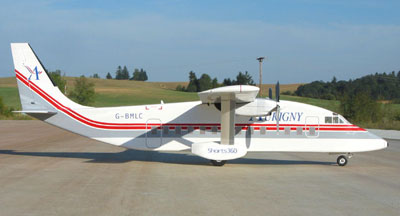
Dear Ken,
The attached photos show my Shorts 360 scale model I completed this August 2004. As noted in a previous Ampeer newsletter, I built it from plans purchased from Aerotech, a French sailplane and eflight modeling magazine. (I have also been told that the magazine recently stopped publication, but I have not confirmed this.)
Construction began in October 2003, and it was primarily built as a test platform for the new 5-blade 6A-hub VarioProps (www.ramoser.de); the building plan calls for direct-drive motors and 6x4 two-blade props.
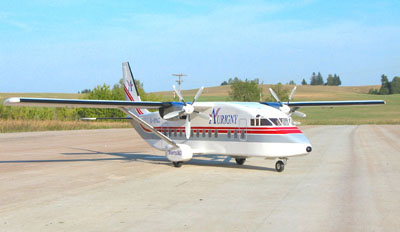
Wing span is 164 centimeters, wing area is 30 square decimeters and all-up-weight is 2240 grams. Controls are aileron, elevator, flap, motor and rudder. An inexpensive power configuration was initially sought using Speed 480/7.2v motors and 3.8:1 planetary gearboxes. The VarioProps are 8.2-inch diameter scale profile blades set at 6-inches pitch. Battery is 10 pushed Sanyo 1950FAUP cells.
The first day of ground trials revealed plenty of power with props set at 5-inch pitch, acceleration was faster than expected and full speed was more than adequate. RPMs were clocked to approximately 5050. Without flaps the model easily became airborne in ground effect, although I never let it lift more than about one foot off the runway. I increased the prop pitch to 6 inches and the only benefit seemed to be faster acceleration, but the top ground roll speed appeared unchanged. As planned, I did not fly the model this day.
Unfortunately, the second day of ground trials showed disappointing performance. It accelerated sluggishly and top ground speed was about two-thirds of the day before. It was not flyable with this power. Subsequent examination suggested highly weakened motor magnets most likely due to overheating. Initially they appeared okay, but a closer - and a much clearer - examination of the brushes showed that they had worn down about one third. That's simply too much for just a few days of high-speed taxi trials!
What happened? Apparently I neglected to install baffles in the motor nacelles in order to redirect the cool airflow upwards around the motors instead of just passing underneath them. Yet I also sense that baffling probably would not have extended the motors' performance that much - maybe a few more flying days. A small consensus amongst friends is that my power setup for this model, especially the 480 motor, was a bad decision.
Since adequate performance with the 480s and gearboxes could not be regained, I refitted the model with the original power setup specified in the plans: direct-drive Permax 450 Turbos and 6x4 props. A few days later, when I got the model back out for further ground tests; the left aileron servo suddenly didn't work. After extensive examination it appears the aileron's HS-56HB servo developed an internal malfunction, as all connections hadn't changed since day one and it had worked perfectly.
Since this happened so late in my summer vacation I was forced to retired the model to its display perch in a local hobby shop. I will return to service the servo and rectify the power setup during my next visit to Oregon - which will probably be in 9 to 12 months.
The 5-blade VarioProps will remain a featured consideration for the actual first flight. But due to this summer's experience I will retrofit the plane with a more insured power setup by using brushless motors, possibly outrunners. And if my money also holds out, by then I might have Lithium Polymer cells.
I return to Germany tomorrow. So it's going to be a long and antsy wait. But better 100% ready for a safe flight than to be sorry...
Regards,
James Frolik
Addendum: 09/23/04
A friend and I have already experimented here with a few geared brushless setups and there will be some more trials to come. So far everything spins the 5-blade VarioProp just fine. Eventually I'll save enough money to buy something by springtime, and hopefully at that time things will also come down a bit in price as the eventual setup I had tried to avoid by using inexpensive 480 motors and gearboxes will still run about five times the cost with ESCs.
Return to "What's In This Issue?"
A Home Depot Field Stand
From Walt Thyng docwt@lightfirst.com

Hi Ken,
I use a field stand due to a bad back and knees.
The one I've been using was made from RCM plans at least 10 years ago.
It weighed 15 lbs and stood 35 inches high. I came across the "Sidekick" at Home Depot. Cost was $19.95; weight as I have it rigged is 10.75 lbs; height 28 inches, folded thickness 3". The folding mechanism is a simply trigger which allows four different height adjustments from 22 to 28 inches (a good modeler could add two inches by drilling two more adjustments holes). Another way would be to cut and extend the legs, which would also increase the footprint, but might create the potential to trip over them. So far I've found the height to work okay.
The second photo shows a quarter inch plywood adaptor plate I made for wider models like my Citabria and P47. It's stowed lengthwise by simply pressing two locator bolts into slightly undersized holes. The same bolts in different holes hold it in place when in use.
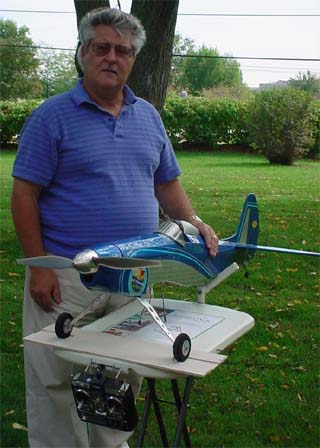 Return to "What's In This Issue?"
Return to "What's In This Issue?"
Electric Kadet LT 40
From Charles Sparrow mobird@mts.net
Hi Ken,
I have my Kadet LT 40 flying now and it performs very well. It's powered with an Astro Cobalt 25 with the 3.3:1 gearbox. I've tried both 15 x 10 and 14 x 12 props. Batteries are Kokams 5S1P 2000mAh. Both props give short take run from grass. I'm getting about 10 - 11 minutes flying circuits with these packs including a few touch and goes. This drops the voltage to approximately 3.75 volts per cell, which is considered just about fully discharged. I put 1400 ma back into the packs at 1C, takes about 53 minutes.
Hope this will be of interest.
Cheers,
Charles Sparrow
Return to "What's In This Issue?"
Jr. Falcon
From Dick Corby sales@altacom.us
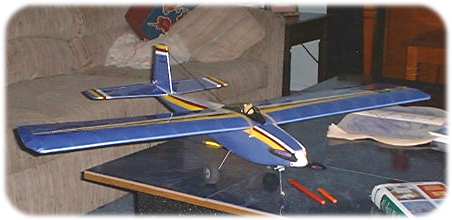
Hi Guys:
Here's the Jr. Falcon I built from a Jim Zare short Kit (Jimzare@aol.com). The kit was very well done and a joy to build. I would recommend his products for anyone looking to build some of the models released back in the 60's and 70's.
Specs:
Full House - Rudder. Ailerons, Elevator, Throttle and Nose Wheel Steering.
Weight 16 oz
Motor AXI 2208/26 Brushless (Hobby Lobby)
Current Draw 10 Amps for 110 Watts per Lb.
Batteries 3S1P 11.1 Volt 1500 Lithium Poly
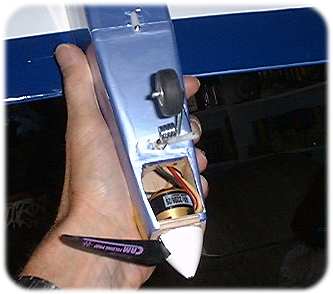
Thank you Dick. Many of you may not be aware of Jim Zare's offerings of some wonderful plane plans, parts and kits. He does not have a Web site, so I have provided his information in this issue. You can have him send you a .PDF file of this information by sending him an email. You could also request the information via postal mail. KM
Return to "What's In This Issue?"
Jim Zare Electric Model Design
Jim Zare (Jimzare@aol.com)
5857 Porsha Drive
Sylvania, Ohio 43560
419-885-4157
EMD 1: Mini Rebel
32" high wing cabin based on Hal DeBolt's 1956 gas model with 193 sq. inches of area and a RTF weight of 7.5 to 11.5 oz. Powered by the MTM Hummingbird, the Potensky 2, GWS or the Astro Brushless 010. With a wing loading of only 5.6-to 8.5-oz./sq. ft. The Mini Rebel is easy to fly in a schoolyard or even a back yard and will loop, roll and spin with the Astro 010. plan $9.00, parts $15.00
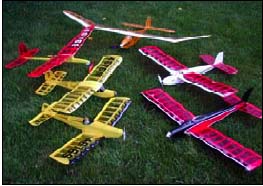
Clockwise from left lower corner: Hummingbird, Mini Rebel, Phantom Flash, Dynamo 400, Jr. Falcon 400, Jr. Skylark 400
EMD 2 Phantom Flash
A 38" replica of the ROG model with 195 sq inches of wing area. RTF weight 6.5 ounces with the MTM Hummingbird or GWS motors. Flies 15 minutes on Nickel Metal Hydrides and one hour on Lithium Poly (2 cells). plan $8.00, parts $14.00
EMD 3 Dynamo 400
Electric powered sport sailplane with a 55-3/4 inches wingspan based on the Dyna Moe and Jabberwock rubber models. For geared speed 400 motors. plan $8.00, parts not available yet
EMD 4 Hummingbird
Electric powered low wing sport aerobatic model designed for the Astro Brushless 010 with a 31-1/2" wingspan and 177 sq. inches of area. Ready to fly weight of 11.5 ounces with Astro Brushless 010 or Speed 280 direct drive motors. plan $8.00, parts $20.00
EMD 5 Firefly
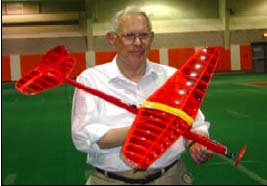
Firefly ROG for Motors up to Speed 280 size, 48-inch wingspan, NACA 6409 Undercambered airfoil
A 46" replica of the Comet Firefly ROG model with 295 sq inches of wing area using the 6409 airfoil. RTF weight 7.5 ounces. For MTM Hummingbird up to Speed 280 motors. Majestic glide, Flies 15 minutes on Nickel Metal Hydrides and one hour on 1020 mAh Li-Polys. plan $9.00, parts $15.00
EMD 6 Jr. Falcon
A 38" sport model, redesigned for direct drive speed 400 with simplified construction. plan $9.00, parts $22.50, canopy $3.50
EMD 7 Jr. Skylark
A 38" sport model, redesigned for direct drive speed 400 with simplified construction. plan $9.00, parts $23.50, canopy $3.50
EMD 9 Whirlwind
A reduced size version of the Woody with a 26-1/2" wingspan. This balsa indoor ROG model designed for small gyms using the superb (new January 2002) Astro Firefly 4:1 motor with the Gunther prop included with the motor. RTF Weight 4.3 ounces. Revolutionary wing construction techniques using a jig and carbon fiber reinforcement. Best weight and flight times with Li-Poly batteries 2 cells, 7.4 volts. plan $9.00, parts $15.00
EMD 11 Woody
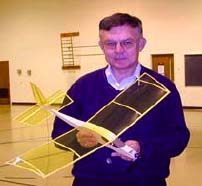
Woody flies in small gyms with the Hitec Feather receiver, 7 cell 50 mAh flight pack, or 3 CR2 Lithiums and 2 HS 55 servos.
A 30" balsa indoor model designed for the Potensky 01, 02 the Dymond 10 or the MTM Hummingbird motors. RTF Weight 4.7 ounces. Revolutionary wing construction techniques using a jig and carbon fiber reinforcement. Uses a 2 cell 880 Lithium Poly pack
plan $9.00, parts $17.50, plan $9.00
EMD 12 Wild Thing
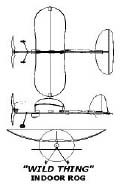
A 24" balsa indoor model designed for the Potensky
01, 02 the Dymond 10, GWS, or the MTM Hummingbird motors. RTF Weight 4.7 ounces. Revolutionary wing construction techniques using a jig and carbon fiber reinforcement.
parts $17.50, plan $9.00
EMD14 Electric Rebel 480
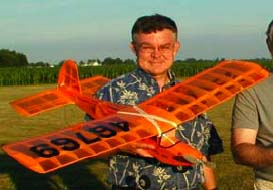
The Electric Rebel 480 is easy to fly in a schoolyard and will loop, roll and fly low and slow.
48" electric model based on DeBolt's original Rebel with 435 sq. inches of area and a RTF weight of 30 oz. Powered by the Graupner Speed 480 3.34:1 gear motor or the Astro Brushless 020 gear motor. With a wing loading of 9.9 oz./sq. ft. The Electric Rebel 480 is easy to fly in a schoolyard and will loop, roll and fly low and slow. Flies for an hour on a two cell Li-Poly 3270 pack. parts $30.00, plan $9.00
EMD 16 Swifty
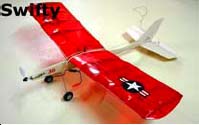
The Swifty is a 25" wingspan indoor outdoor model designed for the Astro Firefly Coreless Motor and a 2 cell 560 mAh Li-Poly pack. RTF Weight 4.5 ounces. plan $9.00
Shipping: Priority Mail $3.95 - Foreign orders add $10.00 for shipping
Please NOTE: I was as careful as possible in transferring this information from Jim's .PDF document. There still could be errors. Please contact Jim for current pricing and availability. KM
Return to "What's In This Issue?"
Why Can't They: Revisited
By Ken Myers
In the September issue of the Ampeer I asked the question, "Why can't they?" I noted that the magazines were not doing a very good job on supplying us the information that we need to make informed decisions about planes and equipment for our hobby. At that time I'd read only the inaugural issue of Fly RC. Since then, I've had a chance to read three more. I am very impressed with Fly RC and the way information is presented. If you've not checked out this excellent magazine, I urge you to do so. While not "perfect", it is pretty darn good in presenting valuable information. Your local hobby shop should be stocking it. That is where I got my issues. You can visit their Web site at www.flyrc.com and sign up for a subscription there. Try it. You'll like it.
Return to "What's In This Issue?"
Sometimes You Find What You're Not Looking For
By Ken Myers
As I noted in the lead article in this issue, sometimes things just fall into place when you are looking at something else.
I was looking at the motor data in Rob Smith's "Sport Electrics: Techniques" column in the October 2004 Quiet Flyer, p 21. It is always nice to see "real world" information presented.
Rob performed real world tests by using the same battery, ESC and props with two motors to compare them.
Rob reached the following conclusion from the data he presented. "As demonstrated by the data from these motor tests, the AXI brushless motor turned each propeller at a higher rpm then did the Top Creations brushless motor. While the brushless motor from Top Creations R/C did not put out as many watts of power or rpm, it consumed less current for the power it produced."
When I studied the same data, I noticed the AXI 2212/26 was much less efficient than the geared Top Creations 22S4019A brushless motor geared 5.28:1.
Rob gave the Kv for each motor and its weight, but those were the only motor parameters that he gave.
Here is his information:
AXI 2212/26 Brushless Motor (Kv 840)
Motor weight with back plate mounting system: 2.25 oz
Top Creations 22S4091A Brushless Motor (Kv 3890), Geared 5.28:1
Motor weight with mounting system: 2.65 oz
First I noted that the Kv of the Top Creations motor with the gearbox was 3890 / 5.28 giving a Kv of 737 or about 100 RPM per volt less than the AXI.
On the Web I found the specification for the AXI 2212/26 to be: Kv 840, Rm 0.210, and Io 0.45. The Top Creations R/C site gave the following for the 22S4091A: Kv 3890, Rm 0.115, and Io 0.65.
The important motor constant to notice is the Rm. The AXI has an Rm almost double the Top Creations. This indicates that that it turns more of the power going into it into heat. That means that it is less efficient.
The reason I looked for those numbers was that from some of Rob's data, it was very clear that the Top Creations geared motor was outperforming the AXI motor, as would be expected, since "outrunner" type brushless motors are not very efficient.
Rob's quoted statement was based on information that he saw when looking at his motor data. For example;
AXI w/10x3.8 APC Slo Flyer
Amps: 12.3
Watts: 127 (note: this is input watts KM)
RPM: 6700
Top Creations w/10x3.8 APC Slo Flyer
Amps: 9.2
Watts: 102
RPM: 6600
When I thought about this data I realized how much more efficient the Top Creations geared motor was.
I've been trying to get a handle on the prop factor to use in the motor power out formula, and have some preliminary findings that indicate APC Slo Fly props have a prop factor of about 1.9 - give or take. Therefore:
AXI Power Out: 10/124 * 3.8/12 * 6.73 * 1.9 = 87 Watts out.
Top Creations Power Out: 10/124 * 3.8/12 * 6.63 * 1.9 = 83 Watts out.
Percent difference 83 / 87 = 4.8%
AXI efficiency: 87 / 127 = 68.5%
Top Creations efficiency: 83 / 102 = 81.4%
Rob also provided the following information on the Top Creations motor w/10x7 APC Slo Flyer:
Amps: 12.3
Watts: 128
RPM: 5660
Note that the Amps and Watts are similar to the AXI with the 10x3.8! What is the power out at this level? 10/124 * 7/12 * 5.663 * 1.9 = 97 Watts out compared to the AXI's 87 Watts out.
The Top Creations motor is providing almost 17% more power for the same input power! That is significant to me.
The AXI w/10x3.8 at 6,700 RPM could produce a flying speed, with an appropriate airframe, of approximately 6.7 * 3.8 = 25.5 MPH, while the Top Creations w/10x7 at 5,660 could produce a flying speed of about 5.66 * 7 = 39.6 MPH on that same airframe. If the design does not require the higher speed, then the diameter can be increased when using the Top Creations' motor giving more thrust.
The conclusion that I reached, using Rob's data, is that the Top Creations R/C geared motor is a more efficient motor than the AXI and allows for either a faster or "more powerful" performer with about the same motor weight.
The important thing to keep in mind is that an outrunner can be lighter and quieter (with no gearbox) than an equivalent geared brushless, but the penalty is that it will be less efficient, especially in the small sizes. The plus is that the outrunner is lighter or close to the same weight as the small ferrite motor it replaces and can take more current. Of course a higher current means shorter flights unless Li-Po batteries are used to replace NiCad or NiMH packs, which is common. Are outrunners better? Not really. The small outrunners have efficiency about equivalent to small ferrite motors, while the larger outrunners have efficiency about equal to Astro Flight cobalt motors.
Least you think I have something against outrunners, my next building project, a Fusion from Electro Flying Models (www.electroflying.com), will be AXI powered.
The point here is that two individuals can look at the same data and "see" things differently.
I was left with an unanswered question. The data shows that both motors drew less current with the 11x4.7 APC Slo Fly props than with 10x7 APC Slo Fly props. Since I don't use Slo Fly props I was surprised, as I have found diameter, not pitch, to be the greater influence. Maybe someone out there can explain this one to me.
Return to "What's In This Issue?"
More Plane Info from Rich Flinchbaugh
7 Avon Ln., South Dennis, MA 02660
I had a chance to meet Rich near the end of summer at the Skymasters' Float Fly. What a pleasure! He recently rejuvenated his 1992 Leisure Playboy and has gotten a Multiplex EasyStar. Here's what he has to say about them. KM
What a delight it is to have the old Leisure Playboy airborne once again! And now, it's better than ever!
Last month I jumped at the opportunity to obtain one of the new MEGA Brushless RCn 400/15/7 "Outrunner" type motors. It's tiny, very light, but packs a lot of power! Especially when teamed with one of the Castle Creations Sensorless controls, a Phoenix 25 (with BEC)!
I was amazed at what a drop of 13 ounce, (approximately 25%) will do in improving the model's performance! From the component photo, note that most of the weight was saved by replacing the geared Astro Flight 05 motor, eliminating the flight battery and associated charging harness, and using a lighter Sanyo NiMH 1050 mAh pack. Also, the system's overall efficiency was improved by about 15%. The first flight was nearly 8 minutes. Why not update one of your past favorites too?
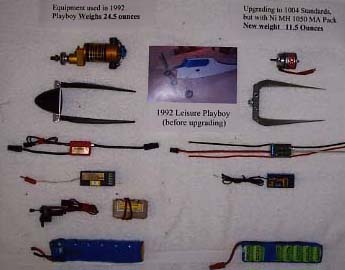
On the left in the photo is the "original" equipment weighing in at 24.5 oz. On the right is the "new" equipment weighing in at 11.5 ounce for a 13 ounce weight savings.
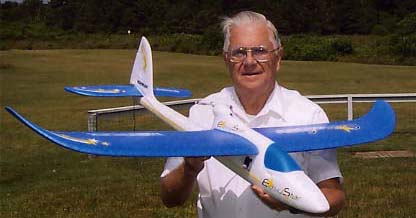
Here's Rich Flinchbaugh with his new EasyStar. Here's what Rich says about it.
It is a popular ARF that's well suited for beginners and old-timers alike. It has a 54" wingspan, is 35" long and has 370 sq.in. wing area. With a flying weight of only 24 ounces the wing loading is only 9 oz./sq.ft. It is easy to fly, and is very stable. It is constructed of Elapor foam, which makes it very rugged and nearly indestructible. This model is powered by a MEGA 16/15/6 Brushless motor using a Castle Creations Phoenix 25 Sensorless Speed control. It is a super combination for maximum efficiency. An ideal model!
Return to "What's In This Issue?"
Porterfield Collegiate & Amptique For Sale
Unfortunately, EFO club member, Ernie LaBelle has to give up flying. He is offering the following items for sale. These items will NOT BE SHIPPED! If you live within a one-hour drive of Waterford, MI, about 60 miles, I will be happy to bring the items to you. Both planes were flown last year. I would recommend that you put new batteries in the transmitters and use new receiver batteries in the aircraft. The best way to contact me is via email, kmyersefo@aol.com. I would prefer to sell the planes as "units", but will consider separate sales. Asking prices for the individual items are listed after the description with the unit price at the end.
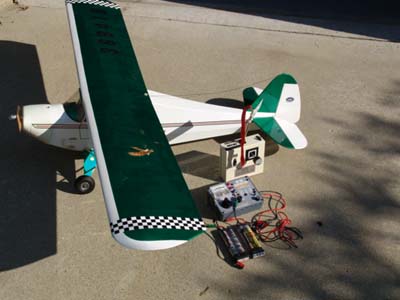
Porterfield Collegiate nicely built semi-scale by an excellent craftsman: $95.00
Astro Flight Geared 25 cobalt about 10 flights on it: $135.00
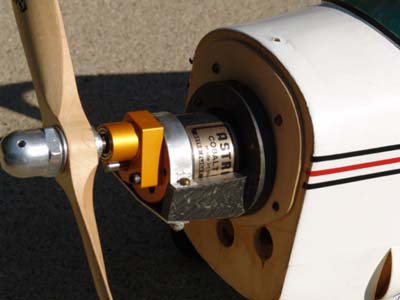
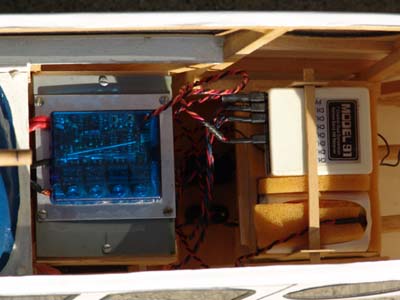
ACE Olympic V Single-stick (gold stickered), Ace 810 receiver, 3 Ace servos, rec. pack and charger: $100.00
Jomar SM-4 ESC: $50.00
1 14-cell Sanyo RC2000 NiCad power pack (2 7-cell packs in series): $50.00
Astro Flight 112 charger NIB (not the PK version): $68.00
If all of the Porterfield equipment is purchased as a single, take it all package: $250.00

Amptique 3-channel trainer/sport plane, excellently constructed, flies GREAT!: $50
Astro Flight 05 geared: $128.00


ACE Olympic V dual-stick (gold stickered), Model 91 receiver, 2 Ace servos, rec. pack and charger: $100.00
Jomar MiniMax ESC: $40.00
Hitec 315PK charger (peak charger for 5-7 cells): $40.00
3 7-cell Sanyo 800AR flight batteries: $20 each/$60 for all three
If all of the Amptique equipment is purchased as a single, take it all package: $200.00
1 only 7-cell Sanyo RC-1700 pack: $10.00
Return to "What's In This Issue?"
| 





















